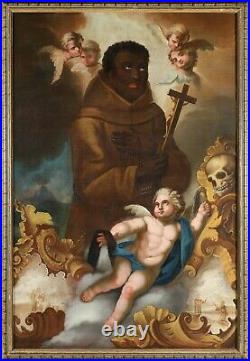

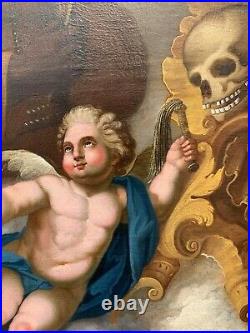
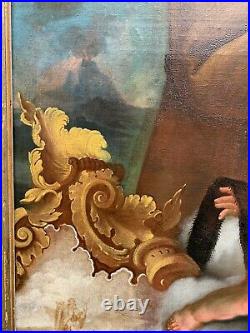
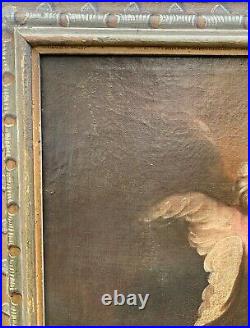


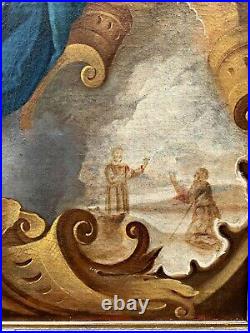
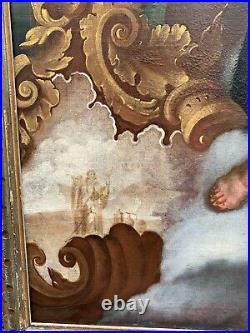


Benedict the Moor, patron saint of all African Americans. Size: 59 x 39.4 in. (150 x 100 cm). Frame: 63 x 43.3 in. (160 x 110 cm). The original canvas consists of 2 parts, which was quite common for paintings of this size at the time. The painting is in good condition. It was cleaned by a restorer and stretched on a new stretcher. The frame is also original and hand-painted. Representations of Saint Benedict the Moor are extremely rare, especially from the 18th century or earlier and especially in this size. If you have any questions, please feel free to contact me. I guarantee for my description. Benedict the Moor, O. Benedetto da San Fratello. 1526 April 4, 1589 was an Italian. Who is venerated as a saint in the. Born of African slaves in. He was freed at birth and became known for his charity. As a young man he joined a. Group, of which he became the leader. In 1564 he was sent to the Franciscan. Where he continued good works. Benedict was born to Cristoforo and Diana Manasseri, Africans who were taken as slaves in the early 16th century to San Fratello (also known as San Fradello or San Philadelphio), a small town near Messina, Sicily. They were given Italian names and later were converted to Christianity. The Italian “il Moro” for “the dark skinned” has been interpreted as referring to Moorish heritage. Because of his appearance, Benedict was also called Æthiops or Niger both referring to black skin color and not the modern-day countries. Benedict’s parents were granted freedom for their son before his birth because of their “loyal service”. Like most peasants, Benedict did not attend any school and was illiterate. During his youth, he worked as a shepherd and was quick to give what he had earned to the poor. When he was 21 years old, he was publicly insulted for his color. His patient and dignified bearing at this time was noted by the leader of an independent group of hermits on nearby Monte Pellegrino, who followed the Rule for hermit life written by St. Benedict was quickly invited to join that community, and shortly thereafter he gave up all his earthly possessions and joined them. He served as the cook for the community and at the age of twenty-eight succeeded Jerome Lanze as leader of the group. In 1564 Pope Pius IV disbanded independent communities of hermits, ordering them to attach themselves to an established religious Order, in this case, the Order of Friars Minor. Once a friar of the Order, Benedict was assigned to Palermo to the Franciscan Friary of St. He started at the friary as a cook, but, showing the degree of his advancement in the spiritual life, he was soon appointed as the Master of novices, and later as Guardian of the community, although he was a lay brother rather than a priest, and was illiterate. Benedict accepted the promotion, and successfully helped the order adopt a stricter version of the Franciscan Rule of life. He was widely respected for his deep, intuitive understanding of theology and Scripture, and was often sought for counseling. He also had a reputation as a healer of the sick. Combined, these characteristics continued to draw many visitors to him. Benedict died at the age of 65 and, it is claimed, on the very day and hour which he had predicted. At the entrance of his cell in the Franciscan friary of St. Mary of Jesus, there is a plaque with the inscription: “This is the cell where Saint Benedict lived”, and the dates of his birth and death – 1524 and 1589. Other sources list the year of his birth as 1526. In a New York Times review of the 2012 exhibit, Revealing the African Presence in Renaissance Europe, at the Walters Art Gallery in Baltimore, Maryland, his birth date is given as 1526. Upon his death, King Philip III of Spain ordered the construction of a magnificent tomb to house his remains in the friary church. Benedict was beatified by Pope Benedict XIV in 1743 and canonized in 1807 by Pope Pius VII. It is claimed that his body was found incorrupt upon exhumation a few years later. Benedict is remembered for his patience and understanding when confronted with racial prejudice and taunts. He was declared a patron saint of African Americans, along with the Dominican lay brother, Martin de Porres. In the United States, at least seven historically-black Roman Catholic parishes bear his name, in the following cities: Washington, DC, New York City, two in Chicago – St. Benedict the African, East and St. Benedict West; in Pittsburgh, Pennsylvania, in North Omaha, Nebraska, and Dayton, Ohio. Benedict the Moor (Winston- Salem, North Carolina) Milwaukee, Wisconsin. Capuchin friars of Milwaukee’s St. Benedict the Moor Parish serve a meal for the homeless six days a week as part of a ministry to reach out to transient, disenfranchised and isolated people. Grambling, Louisiana also has a parish, St. The latest church in the United States to be placed under his patronage is the Parish of St. Benedict the Moor, established in 2003 under the leadership of Father Francis Tandoh, C. A priest from Ghana. The parish maintains a ministry to natives of that country, as well as parishioners from two previous parishes merged to form it. Benedict the Moor Catholic Church, established in 1874 and located in the Historical District of Savannah, Georgia, is the oldest Catholic Church for African Americans in Georgia and one of the oldest in the Southeastern United States. Churches named for him have been founded in Columbus, Georgia and St. Veneration of Benedict is spread throughout Latin America, from Mexico through Argentina. In Venezuela, particularly, his devotion is spread through the country’s various states, and he is celebrated on many different dates, according to the local traditions. The item “St. Benedict the moor, very large rare museum painting Italy ar. 1750″ is in sale since Friday, August 21, 2020. This item is in the category “Art\Paintings”. The seller is “elisa77″ and is located in Eltville. This item can be shipped worldwide.
- Size: Giant (over 60in.)
- Region of Origin: Europe
- Artist: Italian artist ar. 1750
- Style: Baroque
- Listed By: Dealer or Reseller
- Quantity Type: Single-Piece Work
- Painting Surface: Canvas
- Medium: Oil
- Date of Creation: Pre-1800
- Features: Framed
- Width (Inches): 43.3
- Color: Multi-Color
- Subject: Christ
- Originality: Original
- Height (Inches): 63

